The Famous Step Well and Weavers of Patan, India
 Then we were off to the famous World Heritage site of Rani-ki-Vav-the famous step well.
Then we were off to the famous World Heritage site of Rani-ki-Vav-the famous step well.  | 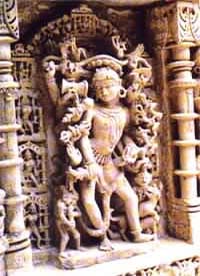 |
| The rani-ki-vav is located 2kms to the north-west of patan, ancient anahillavada, also known as Anahillapura, Analavata, Haharwalah, lies on the left bank of Saraswati river. It is about 57kms from Mehasana, the district head quarter of Gujarat. The historic town of patan was the capital of Gujarat for over 600 years between the 8th and 14th centuries. Under the reign of Bhimdeva (a.d.1022-63), his son Karandeva and grand son Siddharaja, Anahilvada, attained its greatest splendor and the Solanki dominion, its widest extent and highest prosperity. There are many remains of structures in the form of temples, tombs, mosques, wells and tanks, etc. | |
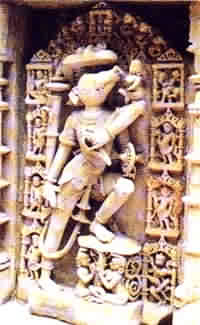 | Rani-ki-vav, the most magnificent step well in Gujarat is said to have been constructed by Udaymati; the consort of Bhimdeva-i(1022-63 ad.), of Solanki dynasty, it is just beside the ancient fortification wall and not far from the embankment of Sahasralinga talav which was excavated under the command of Siddharaja Jayasimha of 11-12th century. |
| The architectural brilliance and elegance of the vav, is represented in its pristine glory in the ornamental work. The beautifully proportioned sculptures, Vishnu (dasha avataras) as Varaha and Kalki, Bhairava, Ganesha, Surya, Kubera, Vishvarupa-Vishnu, Lakshmi-Narayan , Astadikpalas and other forms adorn the walls flanking the staircase and within the walls of the well, being the ample testimony to the mastery of the Solanki sculptors, in depicting ,vigour, beauty and various moods in stone. | 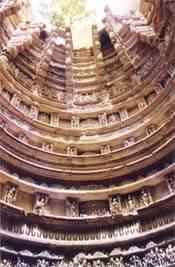 |
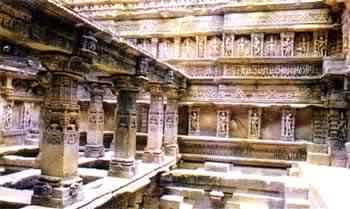 | 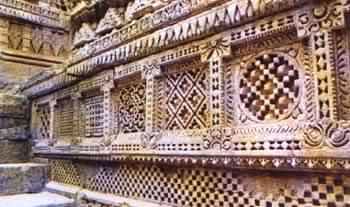 |
| The female figures have been depicted in various poses of apsaras, nagkanya and yogini etc. The shaft of the well is highly ornamented with intricate carvings. This wall projects the large vertical brackets in pairs which supported the different galleries of the well. The brackets are arranged in tiers. The full size sculptures of the stepwell are taken from the entire Hindu pantheon, for example, Vishnu, Shiva and their various aspects appear with or without their consorts. The figure include, the lord of preservation, Vishnu, shown asleep on the coils of the giant multi-headed serpent, ananta, which finds prominent position in the central niche on the different levels of the well. | 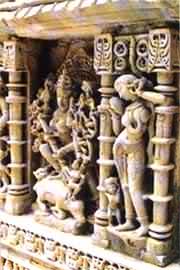 |
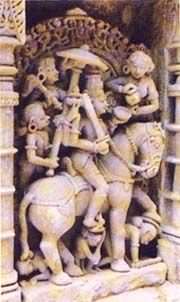 | Traveler arthur mallet visited the site in the first half of 19th century. Henry cousens and james burgess also visited the step well in Patan in 1886-87 a.d. and found that the vav was completely filled up with earth and only back wall of the well and pillar of torana was visible. An early account of Rani-Ki-Vav is found in james tod's "travels in western India" stating that materials of this vav were used in building another on in Patan. The step well was buried for centuries and suffered damage in past due to neglect and flood of the river Saraswati. After independence, the Rani-Ki-Vav came into the custody of archaeological survey of India as protected monument of national importance. Till 1960's nobody knew that there existed the most ornate and highly sculptured vav. At this time, the vav was completely filled up except the top most portion of the well.
|
The painstaking efforts of archaeological survey of India exposed the hidden treasure of sculptural and architectural wealth in its original dimension and splendor through careful excavation, desilting and removal of debris. The loose sculptures, architectural members and stones accumulated in the vav were lifted and set right in their position.
The minute and exquisite carving of this largest and most sumptuous vav is one of the finest specimens of its kind. Befitting its name, the Rani-Ki-Vav is now considered to be the queen among step wells of India.



 After the step well we visited the remaining double ikat weaver in Patan. The weaving of these ikats for saris is a very involved process and can take four to six months.
After the step well we visited the remaining double ikat weaver in Patan. The weaving of these ikats for saris is a very involved process and can take four to six months.
 Preparing the treads for the loom
Preparing the treads for the loom One of the patterns
One of the patterns Preparing the thread for dyeing.
Preparing the thread for dyeing. The old gates of the Patan Fort. Rather neglected.
The old gates of the Patan Fort. Rather neglected.
And lots of camel carts in and around town.

Labels: India and Nepal trip, patan india, stepwell


0 Comments:
Post a Comment
Subscribe to Post Comments [Atom]
<< Home